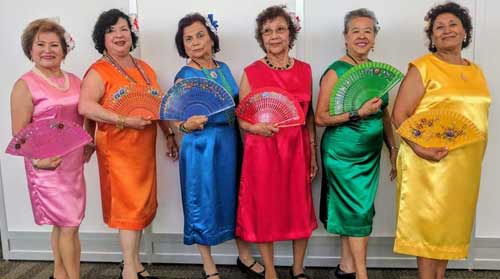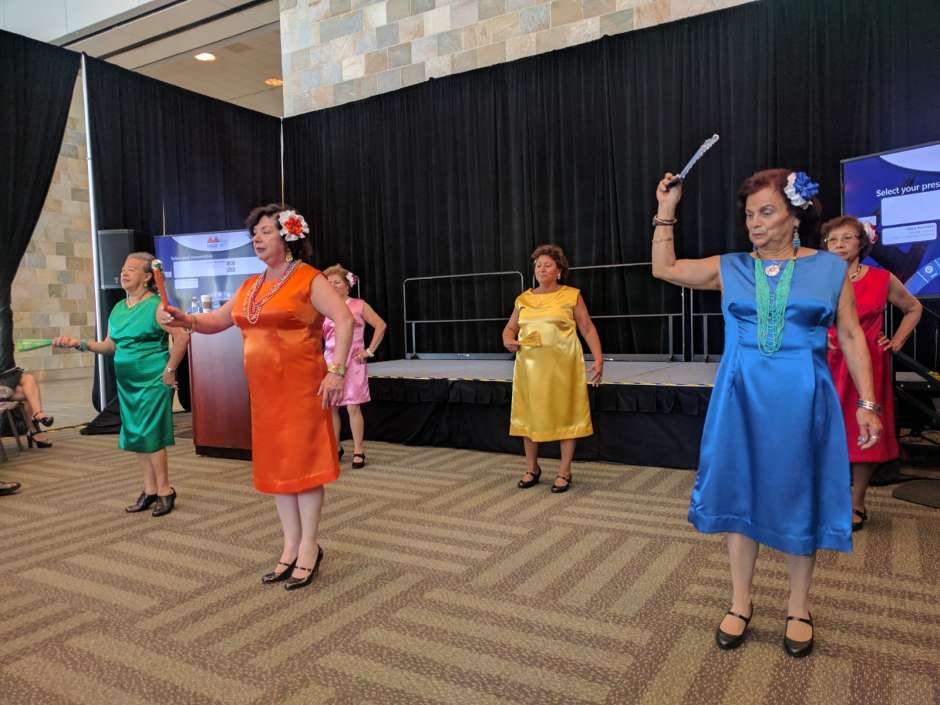by Jacqueline García. This article originally appeared on New America Media.

Ana Bonilla, Socorro Galvez, Dora Aldana, Mayra Dueñas, Maria Navarro and Ana Miranda (shown left to right) participate in a seniors dance group in San Francisco. Photo by J. García.
When a group of elderly women dance, their eyes focus on their hands, their movements and their fans.
Their dresses are colorful, flowers adorn their hair, and their shoes have heels, not too high but elegant.
“Dancing is art and is life,” said Ana Miranda, age 65, after a presentation at the World Conference on Geriatrics and Gerontology in San Francisco in late July. The once-in-four-years conference attracted 6,000 experts in aging from 75 countries.
Miranda along with the other women belong to the San Francisco Mission Neighborhood Center (MNC) Healthy Aging program. She has attended the senior center for more than five years and said the program has helped her greatly, especially to get through stressful periods.
For example, earlier this year she visited her home country of El Salvador to make the difficult decision to disconnect her brother from an artificial respirator. Shortly before, she had had double knee surgery, which prevented her from continuing her work in a children’s center.
“I was depressed, so I told myself, ‘I have to get this pain out.’ I felt ill but I went back to the center and started feeling like I was alive again,” Miranda said.
She arrived just in time when a dance group was being formed to do Cuban danzón and the traditional Mexican sandunga waltz.
Dora Aldana, 75, also was invited to participate and remembers perfectly when they offered the dance class.
“I happily volunteered to participate. At first it was a way to calm my stress,” said Aldana, who is from Guatemala. “This is good for our health and keeps us busy. I never feel alone here.”
Although the class started with more than a dozen women, at the end only six remained.
Invited to Perform
More recently, they were invited to participate in their first public performance at the World Congress, where the professional conference, only held every four years, presented its first-ever Age Stage, a platform of presentations in the arts. The invitation gave the dance group the incentive they needed to take their rehearsals very seriously.
“It took us six months to learn the steps, but we always practiced,” said Ana Bonilla, 73. She retired three years ago, after working for decades in a super market.
“I was invited to this center and then to the dance group, and because I am very active I said yes,” she explained excitedly.
The Salvadoran woman is the mother of three, and although she lives independently, she said that in the center she never feels alone.
“My children are always looking after me and sometimes they tell me they need to make an appointment to see me because I keep myself so busy,” said Bonilla with a laugh. “But if I stay in the house I’m just looking at the ceiling and then the thoughts of when I am going to die appear. That’s horrible,” she said.
Aldana agreed. Although she has a son living elsewhere in the Bay Area, the center offers her and other seniors more frequent opportunities to make social connections.
She noted, for instance, “Here we have breakfast, we share our food and then we go and do what we want. On Tuesdays we take dance classes.”

The colorful costumes of dancers at San Francisco’s Mission Neighborhood Center were made by dancer-group member Mercedes Ramírez, age 75. (Jacqueline García)
Staying Active
At the center about 70 percent of the participants are women, and the dance class is composed of women ages 60 and older, said María Bermúdez, director of operations of the organization.
“At first the ladies are intimidated; they do not believe that they will remember the steps, but within a few weeks they are lively and happy,” explained Bermúdez. “They are much more confident, more skillful, more eager to live.”
Research reveals that people who stay physically active improve their quality of life in order to live independently. They also reduce the risk of depression because they interact socially and prevent isolation, explains AARP, an association for people 50 and over.
Keeping the mind occupied by listening to music, reading and continuous learning reduces cognitive impairment, according to AARP.
If an older person, falls it can impair the person’s health, said Aurora Alvarado, community services coordinator at the center. “This is because their feet no longer match and lose coordination,” she said, referring to physical changes as people age.
Therefore, she and others say, classes such as aerobics, yoga and dancing allow older adults to work on the coordination of mind and body.
Not a Nursing Home
Alvarado said that it is common for Latinos to compare the senior center with a nursing home. “But we make them see that this is a place where they can feel at home,” she emphasized.
“Along with the classes, we take them to the movie theater and to Cosco for their shopping. And then we take them to their houses with their purchases,” added Alvarado.
Bonilla said that before participating in the center she had the idea that the “elderly were just sleeping,” but when she arrived he noticed the opposite.
“I saw that everyone is more active than me and that motivates me,” she said.
Miranda confirmed that senior center improved their health. She stated, “I no longer feel the pain in my knees, and I am always very active. I feel very happy!”
Jacqueline Garcia wrote this article for La Opinión with the support of a journalism fellowship from New America Media, the Gerontological Society of America and AARP.
The opinions expressed in this article are those of the author and do not necessarily reflect those of the Diverse Elders Coalition.

